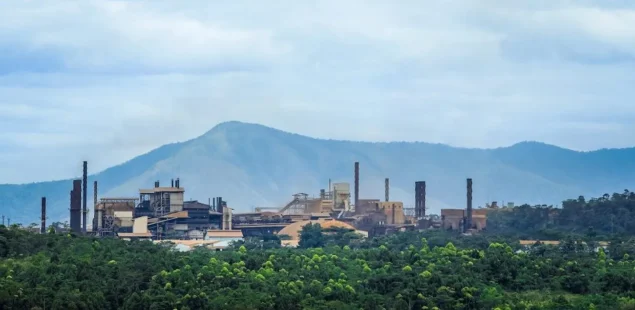
BHP Group, the world’s largest mining company and biggest iron ore producer, and Rio Tinto, a British-Australian multinational and the world’s second-largest mining company, have experienced share price pressure despite projections of massive demand increases for critical minerals. The International Energy Agency forecasts copper demand will increase 50%, nickel demand will more than double, and lithium demand will rise 11-fold between 2020 and 2040 as global electric vehicle adoption and renewable energy infrastructure development accelerate.
The stock performance contrasts sharply with the sector’s fundamental outlook, as both companies struggle with structural shifts away from iron ore dependence while attempting to capitalize on green transition opportunities. Rio Tinto’s announcement on May 22 of CEO Jakob Stausholm’s surprise resignation has added uncertainty to the sector’s leadership during this critical transition period.
Iron Ore Revenue Decline Drives Structural Challenges
Iron ore generates the majority of cash flow for both BHP and Rio Tinto, but prices have fallen 20% over the past 18 months as Chinese steel manufacturers face continued pressure from the country’s ongoing real estate sector depression. Chinese steel producers represent the largest global buyers of iron ore, making their reduced demand a critical factor in mining company revenues and profitability.
The iron ore price decline has forced both companies to accelerate diversification strategies away from their traditional revenue base. Industry analysts note that replacing the substantial cash flows generated by iron ore operations over the past two decades presents one of the mining sector’s most challenging strategic transitions.
Copper Market Dynamics and Production Challenges
Copper prices have increased 30% over the same 18-month period that iron ore declined, reflecting growing demand from electric vehicle manufacturing and renewable energy infrastructure projects. However, copper production costs have tripled since 2010 as established ore bodies like BHP’s Escondida mine in Chile reach maturity and new prospects require development in more remote locations with limited water access and higher operational complexity.
The transition to copper production requires substantial time investments, with mining operations lacking the rapid response capabilities that characterize shale oil and gas drilling. New copper projects typically require decade-long development timelines from discovery to commercial production, limiting companies’ ability to respond quickly to market demand shifts.
Industry Consolidation and Competitive Pressures
The mining sector’s fragmented structure limits most companies’ ability to pursue large-scale greenfield projects independently. Only BHP and Rio Tinto possess sufficient financial resources to undertake $10 billion development projects without risking company viability on single ventures. This constraint has driven merger and acquisition activity, with recent discussions including potential combinations between BHP and Anglo American, and Rio Tinto with Glencore, though few transactions have materialized.
Chinese state-owned Zijin Mining Group has emerged as an aggressive competitor, targeting a 50% increase in copper output between 2023 and 2028 through expansion of recent acquisitions spanning from the Democratic Republic of Congo to Serbia. This expansion strategy positions Chinese companies to capture growing market share in critical mineral production.
Lithium Investment Risks and Market Volatility
Rio Tinto’s lithium strategy under departing CEO Stausholm illustrates the sector’s investment challenges, with the company investing nearly $10 billion in lithium assets while prices plunged 90% from 2022 peaks. The investment timing coincided with lithium market oversupply and reduced electric vehicle demand growth, creating substantial short-term losses despite long-term demand projections.
The lithium market volatility demonstrates the risks associated with betting on emerging battery metals, where supply and demand imbalances can create extreme price swings. Industry observers suggest that contrarian investment timing during market downturns may prove beneficial for long-term positioning in critical minerals.
Market Valuation and Investment Outlook
Both BHP and Rio Tinto currently trade at discounts to analyst valuations despite their strategic positioning for the green transition. Historical precedent suggests mining stocks can generate substantial returns when supply-demand fundamentals align favorably, with BHP achieving quadruple total returns over five years following its 2016 trough.
The sector faces a critical supply-demand imbalance for copper and other critical minerals, with insufficient production capacity to meet projected green transition requirements. Without substantial new investment and production increases, copper prices could experience dramatic increases that would impact electric vehicle affordability and renewable energy project economics.
Company Background and Market Context
BHP Group operates as Australia’s largest mining company with extensive iron ore operations in Western Australia’s Pilbara region, copper mines in Chile and Australia, and diversified commodity production including coal and petroleum. The company generated $56.03 billion in revenue during fiscal 2024, with iron ore contributing approximately 60% of underlying earnings before interest, taxes, depreciation, and amortization.
Rio Tinto ranks as the world’s second-largest metals and mining corporation, operating major iron ore facilities in Australia, aluminum smelting operations, and copper mines across multiple continents. Rio Tinto reported $53.7 billion in revenue for 2024, with iron ore operations in Australia’s Pilbara region generating the majority of cash flows. Rio Tinto has been actively expanding its battery materials portfolio through lithium acquisitions and development projects.
Critical minerals including copper, nickel, and lithium have become essential components of the global energy transition, with copper serving as the primary conductor in electric vehicles and renewable energy systems. Current global copper production totals approximately 28 million metric tons annually, with demand projections suggesting requirements could reach 42 million metric tons by 2040. The supply-demand imbalance reflects the extended timelines required for new mine development and the increasing complexity of accessing remaining high-grade ore deposits worldwide.



